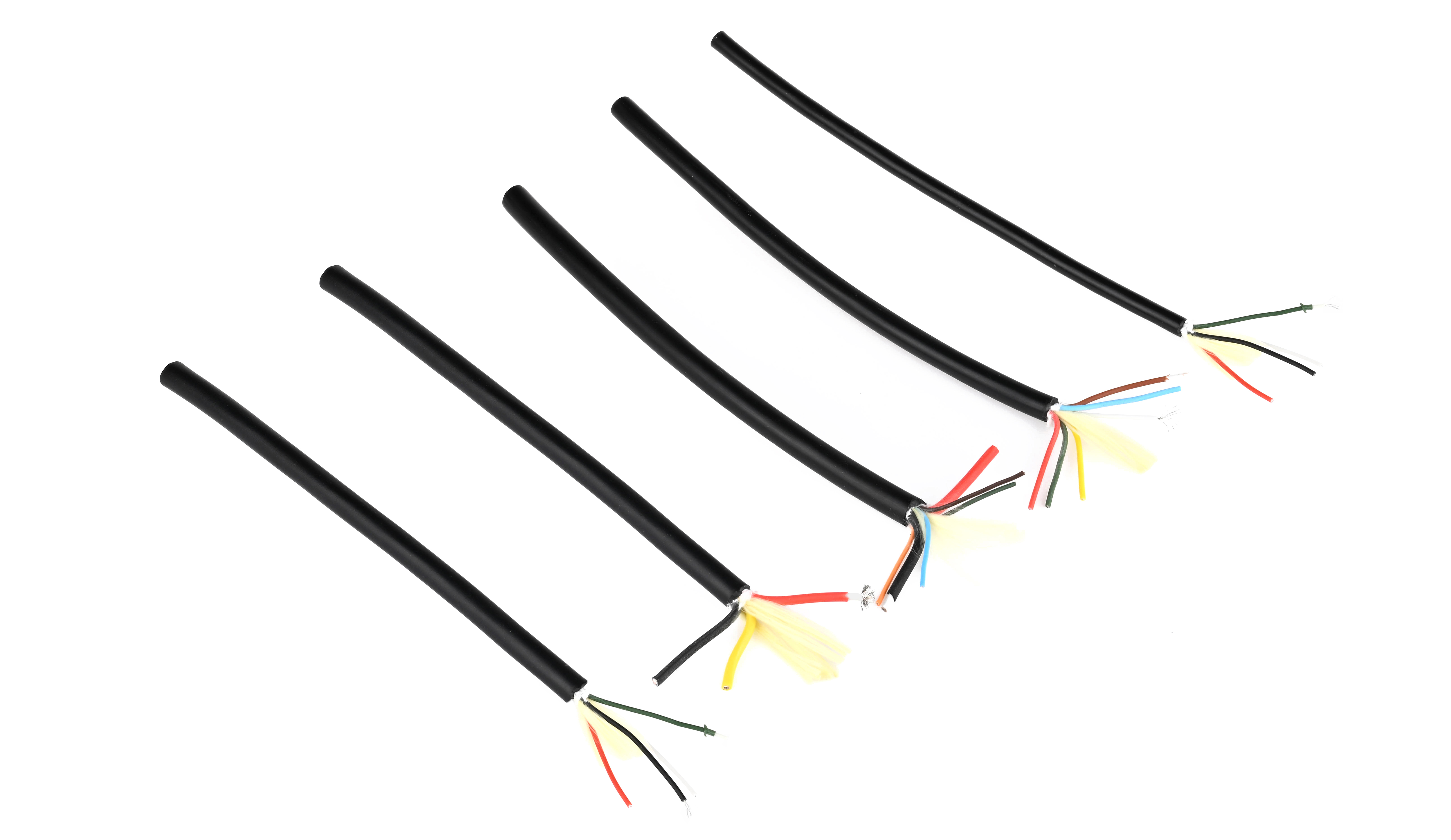Description
The underwater cable, suitable for both fresh and saltwater environments, used in underwater robots, underwater accessories, etc., can be used in water along with the equipment. It's important to note that waterproofing treatment is required at both ends of the cable.
The core and outer jacket materials are specially adjusted to bond well with resin or vulcanized rubber, and each core has a double-layer structure. It is filled internally with Kevlar for tensile strength.

Shipping List
- Cable of Corresponding Specifications× N meters

Specifications
| Item | SKU | OD | Core Color | Unit Price(US$) |
|---|---|---|---|---|
| 3x16AWG Underwater Cable | 13010105-0016 | 7.5±0.15 | Red, Black, Yellow | 6.6 |
| 6x24AWG Underwater Cable | 13010105-0024 | 7±0.15 | White, Yellow, Green, Red, Blue, Brown | 5 |
| 4x28AWG Underwater Cable | 13010105-0028 | 5.2±0.15 | White, Black, Red, Green | 4 |
| 2x16AWG+4x26AWG Underwater Cable | 13010105-1626 | 8±0.15 | Red, Black, Blue, Orange, Green, Brown | 6 |
| 2x24AWG+2x26AWG Underwater Cable | 13010105-2426 | 7.5±0.15 | Red, Black, White, Green | 5 |
| 3x20AWG Underwater Cable | 13010105-0116 | 6.0±0.15 | Red, Black, Yellow | 4.8 |
| Item | 3x16AWG Underwater Cable | 6x24AWG Underwater Cable | 4x28AWG Underwater Cable | 2x16AWG+4x26AWG Underwater Cable | 2x24AWG+2x26AWG Underwater Cable | 3x20AWG Underwater Cable |
| Conductor | Tinned Copper Wire 169*0.10 | Tinned Copper Wire 19*0.127 | Tinned Copper Wire 13*0.10 | Tinned Copper Wire 104*0.127; 19*0.1 | Tinned Copper Wire 19*0.127; 19*0.1 | Tinned Copper Wire 119*0.08 |
| Insulation | Double-Layer PUR | Double-Layer PUR | Double-Layer PUR | Double-Layer PUR | Double-Layer PUR | Double-Layer PUR |
| Insulated Wire Diameter | 2.4±0.1 | 1.4±0.1 | 1.2±0.1 | 2.8±0.1; 1.2±0.1 | 1.6±0.1; 1.4±0.1 | 1.8±0.1 |
| Filler | Kevlar, Non-Woven | Kevlar, Non-Woven | Kevlar, Non-Woven | Kevlar, Non-Woven | Kevlar, Non-Woven | Kevlar, Non-Woven |
| Jacket Material | Polyether PUR | Polyether PUR | Polyether PUR | Polyether PUR | Polyether PUR | Polyether PUR |
| Jacket Thickness | 1.15 | 1.4 | 1.0 | 1.1 | 1.3 | 1.0 |
| Jacket Color | Black | Black | Black | Black | Black | Black |
| Conductor DC Resistance | ≤13.8Ω/km | ≤75Ω/km | ≤185Ω/km | <13.7Ω/km;<122Ω/km | ≤75Ω/km | ≤32Ω/km |
| Test Voltages | 1000V/min(AC) | 1000V/min(AC) | 700V/min(AC) | 1000V/min(AC) | 1000V/min(AC) | 1000V/min(AC) |
| Insulation resistance(20°C) | ≥20MΩ.km | ≥20MΩ.km | ≥20MΩ.km | ≥20MΩ.km | >10MΩ.km | ≥20MΩ.km |
| Rated Voltage | Power Line 300V | Power Line 300V | Power Line 300V | Power Line 300V | Power Line 300V | Power Line 300V |
| Minimum Bending Radius (Fixed) | 4D(D=Cable Diameter) | 4D(D=Cable Diameter) | 4D(D=Cable Diameter) | 4D(D=Cable Diameter) | 4D(D=Cable Diameter) | 4D(D=Cable Diameter) |
| Minimum Bending Radius (Occasional Movement) | 7.5D(D=Cable Diameter) | 7.5D(D=Cable Diameter) | 7.5D(D=Cable Diameter) | 7.5D(D=Cable Diameter) | 7.5D(D=Cable Diameter) | 7.5D(D=Cable Diameter) |

Guides
FAQ
● How to waterproof the cable ends?
Waterproofing methods depend on specific requirements, considering factors such as whether it is detachable, waterproof depth, lifespan requirements, environmental conditions, connection methods (line-to-line, watertight enclosure outlet), etc.
Simple Waterproofing Treatment: Use Cable Penetrator, resin potting, etc.
Waterproofing Treatment within 1000 meters depth: Traditional encapsulation materials sealing, such as gel beads, gland heads used in pump cables, etc.
Deepwater Waterproofing Treatment: Sealing with vulcanized rubber, pressing waterproof connectors, fixed joints made of polyurethane, etc.
● What is the minimum order quantity?
The minimum order quantity is 1 meter, and prices decrease with larger quantities.
● How to strip the cables?
Cable stripping can be done using diagonal pliers or a knife blade. Stripping tools or pneumatic/electric wire strippers are used for batch cutting. Kevlar inside may require separate cutting.
● What happens if the bending radius exceeds the minimum bending radius?
There is a risk of cable jacket rupture with prolonged excessive bending, and prolonged exposure to ultraviolet radiation should also be avoided.
● What is the operating temperature range?
The long-term operating temperature is -20°C to 80°C, and the storage temperature is -20°C to 50°C.
● Can it be used if the cable jacket is damaged?
A damaged cable jacket may lead to short circuits or open circuits and can affect waterproofing.
